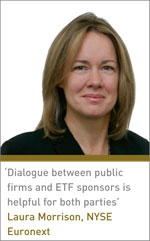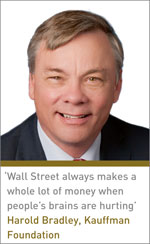IROs can’t afford to ignore the growing relevance of ETFs
With the exchange-traded fund (ETF) market having ballooned to roughly $1.2 tn in assets under management, IROs are starting to consider ways to make the acquaintance of ETF sponsors.
Doing so can be complicated, however, because ETFs are tied to indexes or baskets of stocks, so they operate according to rules outside the classic IR playbook.
Whether or not it makes sense to build a relationship with an ETF sponsor, IROs should at least know the criteria for inclusion in an ETF and something about the managers making decisions. ‘Having an open line of dialogue between public firms and the [ETF] sponsors is helpful for both parties,’ says Laura Morrison, senior vice president of global index and exchange-traded products at NYSE Euronext.
‘Having an open line of dialogue between public firms and the [ETF] sponsors is helpful for both parties,’ says Laura Morrison, senior vice president of global index and exchange-traded products at NYSE Euronext.
ETFs are claiming more IRO time and attention simply because of their size. Morrison notes that on a typical trading day in April, 1.07 bn ETF shares changed hands with a value of approximately $61 bn.
Put another way, around 27 percent of all consolidated trading in the US is in the form of ETFs.
What may matter more than the sheer size of the ETF market is its phenomenal growth rate. Christian Magoon, founder of Magoon Capital, a consultancy for the ETF industry, points out that in 2011 $120
bn flowed into ETFs – more than twice the amount flowing into mutual funds.
Getting to know you
Classic IR strategy might have little effect on iShares and the ETF divisions at Vanguard or State Street Global Advisors, but IROs can’t afford to ignore this market segment.
First, says Morrison, IROs need to know which ETFs they’re included in, and what the weighting of their company is within a given fund. She also advises IROs to research an ETF’s creation and redemption processes.
Magoon advocates forging relationships with the companies creating new indexes on which ETFs are based. ‘More and more indexes are put together with opinion-based criteria,’ he explains.
‘It makes sense for IROs to talk to some of the largest index providers – such as S&P and Dow Jones – as they’re constantly creating new indexes that are then the basis for ETFs.’
IROs are also identifying new opportunities given the latest trend in ETFs: actively managed funds. Morrison says there are now 47 actively managed ETFs listed on NYSE Arca, and assets in this segment have grown at a compounded annual rate of roughly 67 percent over the past three years.
What’s more, she points out that more than 30 prospective issuers have filed plans with the SEC to launch active ETFs. ‘It’s particularly helpful for IROs to build a relationship with the sponsors when they’re researching which funds to launch,’ she says.
Even once an active ETF is up and running, however, managers exercise some discretion over the equities they buy. Morrison says the main difference between an actively managed ETF and a mutual fund is that the ETF discloses holdings every day – a real boon for an IR professional.
Noah Hamman, founder and chief executive of AdvisorShares, which has 13 actively managed ETFs and $555 mn under management, cannot recall ever having been approached by a public company interested in discussing its fundamentals.
But he believes ‘any ETF manager who has a fundamental approach to managing money would welcome any contact or information from a public company.’
Other IROs are making overtures to ETFs for governance reasons. ‘It would be a good idea for IROs to know proxy voting policies and the people who make the proxy voting decisions at ETFs,’ observes Jon Lukomnik, executive director at the IRRC Institute. ‘Many of the larger ETF firms have corporate governance specialists with whom you can engage.’
Areas for concern
Being included in an ETF isn’t always cause to throw a party, however. Harold Bradley, chief investment officer at the Kauffman Foundation, points out that IWM, the iShares Russell 2000 Index Fund, has been known to be more than 100 percent short. And high levels of short interest can be particularly damaging for small-cap companies, he adds.  Another area of concern to IROs is trading idiosyncrasies possibly sparked by ETFs. ‘ETFs are affecting the movement of securities in what I’d consider a negative way,’ maintains Bradley.
Another area of concern to IROs is trading idiosyncrasies possibly sparked by ETFs. ‘ETFs are affecting the movement of securities in what I’d consider a negative way,’ maintains Bradley.
He cites the collapse of the VelocityShares Daily 2x VIX Short-Term Futures ETN (TVIX) ‘as all the gun we need to have smoking’. In March the TVIX fell nearly 30 percent while VIX futures rose; the ETN and VIX indices usually trade in tandem.
Bradley also attributes several recent anomalies – stock prices climbing precipitously in the last 30 minutes of trading for no discernible reason – at least in part to ETFs.
‘When stocks move that rapidly together without any news, there is a problem in the structure of the marketplace,’ he says.
‘What ETFs are doing is twisting how stocks trade and undermining the confidence in the appropriate price being established for companies and their success in the market. They’re creating far more ‘market events’ where the market has a spastic response.’
One solution to this may be better regulation. Bradley urges public companies to lobby for the right to opt out of an ETF. He also suggests capping shorting in ETFs at 10 percent and monitoring all trades to ensure they settle within the mandated timeframe (T+3).
But others argue that ETFs have become a media scapegoat for market volatility, high equity correlations and unexpected returns for individual stocks, when there is no convincing statistical evidence to support these claims.
In a March 20 Credit Suisse report entitled ‘How much do ETFs influence stocks?’, Victor Lin argues that just 15 percent of ETF trading actually results in trading of the underlying stock.
He believes ETFs are being blamed because their growth coincided ‘with a shift to a more macro-oriented and uncertain economic environment than the market has experienced in recent memory.’
Whether ETFs are causing market irregularities remains open to debate. In the meantime, many IROs are trying to get to grips with ETFs. ‘If you’re not a professional trader or portfolio manager, ETFs are hard to understand.
Your brain will hurt,’ concludes Bradley. ‘And Wall Street always makes a whole lot of money when people’s brains are hurting.’
Breaking the golden rule?
Some IROs fret that ETFs are making a company’s stock less attractive to prospective investors. This worry has been frequently voiced in the gold sector, where a company’s outlook often depends more on the outlook for precious metals than on corporate strategy or the perceived quality of management.
The best-run gold companies may feel the popularity of ETFs is hurting their performance, says Magoon. ‘There’s a decent argument that some of the advantage of being a strongly performing gold company relative to your peers has been lost because of the flows into ETFs for gold,’ he notes.
In response, some gold firms have begun offering higher dividends as a way to woo investors who might otherwise prefer an ETF. As of November 2011, dividend payments for the top 20 gold miners were up 44 percent from 2010, according to a recent PwC report; in 2010, gold company dividends increased only 18 percent from 2009.
Meanwhile, in March, Gold Bullion International introduced a service for dividend-paying companies that offers shareholders the opportunity to accept their dividend in physical gold or silver.
Both Magoon and Morrison are skeptical of the argument that offering a dividend will attract investors that otherwise would have chosen an ETF, as many ETFs return the dividends they earn to investors on a quarterly basis.
Morrison also feels many IROs concerned that investors are selecting ETFs over the underlying security are missing a larger point.
‘Someone said to us, We’d rather the investor invest in us directly than in the ETF that wraps our product,’ she says. ‘But investors are investing in your company when they invest in the ETF.’










